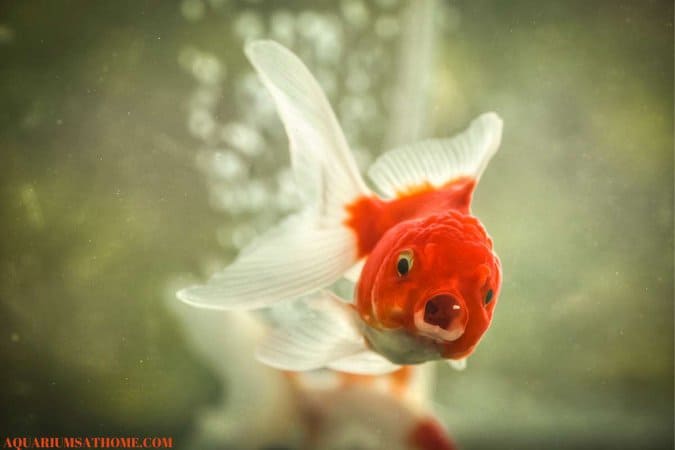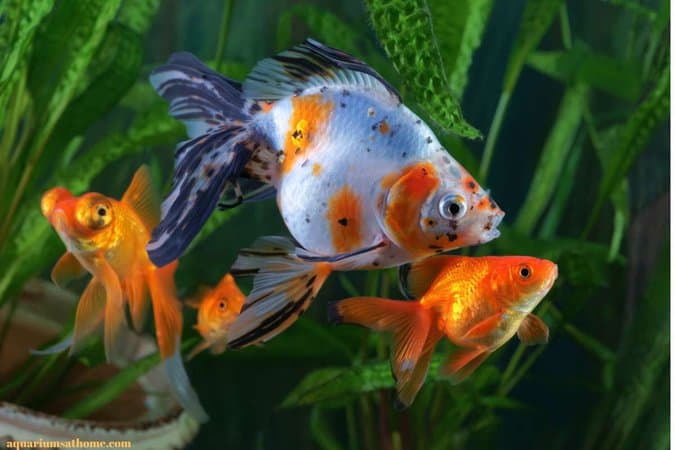Goldfish are a type of carp native to eastern Asia. People in China have been keeping these fish as pets for generations. It’s widely believed that goldfish were the first foreign species to be introduced to North America from overseas.
A long-time favorite among freshwater aquarists, goldfish are renown for their colorful appearance, hardy nature, and low maintenance requirements. If you’re ready to dive deeper into the aquatic world of the goldish and learn more about its origin and evolution, then please read onward…
Ancient China: The Birthplace of Goldfish
The first mentioning of goldfish in Chinese literature was in 1276 when an Asian publication discussed the breeding and selling of goldfish in Hangchow. This species represents harmony and prosperity to the people of China. A popular Chinese New Year symbol depicts a child holding a goldfish and a lotus flower.
In ancient China during the Sung Dynasty (960-1279), domestic goldfish breeding began. The imperial family viewed this species as a symbol of wealth. They began intentionally breeding these fish in yellow to coincide with their color-themed rule. Only the imperial family could raise and keep yellow goldfish.
Prior to the Sung dynasty, goldfish (as a type of carp) were mainly used for food. Once the imperial family took an interest in breeding and keeping this species, their popularity expanded to the masses. Goldfish came to represent high-class and had a significant impact on the culture of the time.
Goldfish Spread Across the Globe
Chinese traders introduced Japan to goldfish in 1502. They began selling them to Japanese nobility and the samurai as an omen of good fortune. In the 1900’s, the Japanese began breeding shubunkins which are a cross between demekin goldfish (ryukin mixed with black moor) and the common goldfish.
Goldfish made their way to Europe in the 1611. They were first introduced in Portugal and from there, to other European countries. Their metallic appearance – reminiscent of gold – was a symbol of wealth and good fortune, making them a highly sought after commodity throughout the continent.
Goldfish were finally introduced to North America in 1850. The first known species of carp to make its way overseas, goldfish have become invasive after years of being released into the wild. Their unwanted presence in Canadian waters threatens the population of native fish and disrupts the ecological balance.

The Evolution of Goldfish Varieties
It’s believed that goldfish originated in ancient China from a wild population of crucian carp which is how they got their trademark golden appearance. They thrive in slow-moving, slightly murky, cold bodies of freshwater in Asia, Europe, and North America.
There are currently 33 different types of goldfish, many of which are man-made variations of standard breeds. The most popular types include the common, comet, oranda, ranchu, ryukin, shubunkin, fantail, and bubble eye goldfish.
Fancy goldfish are believed to be the hybrid offspring of either a common or comet goldfish and a fantail goldfish. This variety is long and streamlined with an erect dorsal fin that extends down the back. It also has a unique double tail, much like that of the fantail goldfish only shorter.
The Science of Goldfish: Anatomy and Physiology
The physical characteristics of goldfish vary greatly. Regarding coloration, goldfish can range from olive green to gold with the most common shades being red and orange. They can also be found in hues of bluish-grey, brown, and black.
Goldfish breathe by taking water into their mouths and then forcing it through their gills. As oxygen-rich water passes over these feathery organs, it’s dissolved into the bloodstream where it then travels down the body and into the cells.
Goldfish reproduce at a rapid rate under the right environmental circumstances. The males typically chase after the females, encouraging them to release their eggs. Once released, the males ‘milt’ or fertilize them. Females can lay up to 1000 eggs in a single breeding season which take 2-7 days to hatch.
The average lifespan of the goldfish is 10-15 years in captivity. They have the potential to live much longer (20 to 30 years) in optimal water conditions. Sadly, their penchant for longevity is often stifled by inadequate care and improper housing.
Goldfish in Art and Literature
Goldfish are traditional symbols of luck and prosperity. They’re typically depicted as deities in classical art and literature. For example, the image of a pair of goldfish symbolizes love and fertility. Ancient stories and fairy tales often tell of goldfish granting wishes or making dreams come true for humans.
Goldfish in contemporary art and media aren’t unlike that of ancient Chinese culture. North American exhibits showcasing goldfish can be seen at The Metropolitan Museum of Art and the Smithsonian Art Museum, just to name a few.
The Role of Goldfish in Culture and Society
In China, goldfish have religious connotations dating back to the 9th century. In Buddhism, for example, goldfish mutants – if captured by humans – weren’t eaten but rather released into sacred ponds as an act of mercy known as fang sheng.
The Chinese have been keeping goldfish are pets since the 17th century. This practice has carried over into North America since 1850 when they were introduced to the western world. Aquarists from around the globe have taken an interest in goldfish rearing, so much so that it’s become more than just a hobby.
Goldfish rearing has become a competition nowadays with various events around the world dedicated to showcasing this colorful carp fish in all its glory! The Canadian Goldfish Virtual Competition is one such event, not to mention the ever-popular Goldfish Scooping World Championship in Japan.
The Future of Goldfish
The future of goldfish is an uncertain one. Unauthorized release into open waters has caused them to become an invasive species in North America. Being flushed down toilets or indiscriminately set free in freshwater lakes has led to this environmental threat.
Advancements in conservation have helped control goldfish overpopulation in unwanted waterways. A variety of physical methods have been adopted in North America to help manage this problem including the removal of fish with nets, the use electrofishing gear, and the regulation of water levels and flows.

Caring for Goldfish (Both Past and Present)
In days of old, goldfish were a prized possession and meticulously cared for. Documents have been recovered from 10th century Chinese monasteries that outline the proper feeding and care of pet goldfish by the monks of the time.
Caring for goldfish today is easy, if you provide them with the appropriate aquatic conditions in which to thrive. The perfect choice for beginner aquarists, goldfish are resilient and can live for many years in captivity. All they really need is clean water, nutritious food, and a large space to forage and explore.
Conclusion
The rich and diverse history of goldfish is part of their enduring appeal. Aquarists from around the world have come to revere and appreciate this colorful carp fish – even to the point of creating competitions to showcase them. Preserving their existence though adaptation and conservation is of vital importance.
I hope you’ve found it to be both interesting and informative. Thanks for reading and good luck with your future aquarist endeavors.






